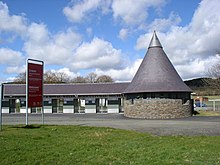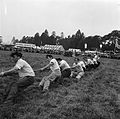
Until 1974, Brecknockshire, also formerly known as the County of Brecknock, Breconshire, or the County of Brecon, was an administrative county in the south of Wales, later classed as one of the thirteen historic counties of Wales. Named after its county town of Brecon, the county was mountainous and primarily rural.

Until 1974, Radnorshire was an administrative county in mid Wales, later classed as one of the thirteen historic counties of Wales. It covered a sparsely populated area, and was bounded to the north by Montgomeryshire and Shropshire, to the east by Herefordshire, to the south by Brecknockshire and to the west by Cardiganshire.
The National Farmers' Union (NFU) is a member organisation/industry association for farmers in England and Wales. It is the largest farmers' organisation in the countries, and has over 300 branch offices.

Presteigne is a town and community in Radnorshire, Powys, Wales on the south bank of the River Lugg. Formerly the county town of the historic county of Radnorshire, the town has, in common with several other towns close to the Wales-England border, assumed the motto, "Gateway to Wales". The border wraps around three sides of the town. Nearby towns are Kington, Herefordshire to the south and Knighton to the north, and surrounding villages include Norton and Stapleton. The town falls within the Diocese of Hereford. The community has a population of 2,710; the built-up area had a population of 2,056.
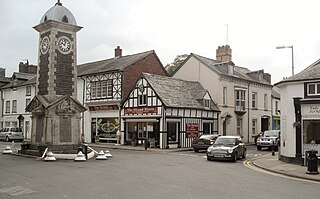
Rhayader is a market town and community in Powys, Wales, within the historic county of Radnorshire. The town is 20 miles (32 km) from the source of the River Wye on Plynlimon, the highest point of the Cambrian Mountains, and is located at the junction of the A470 road and the A44 road 13 miles (21 km) north of Builth Wells and 30 miles (48 km) east of Aberystwyth.

Builth Wells is a market town and community in the county of Powys and historic county of Brecknockshire (Breconshire), mid Wales, lying at the confluence of rivers Wye and Irfon, in the Welsh part of the Wye Valley. In 2011 it had a population of 2,568.

Llanelwedd is a village and community near Builth Wells, in Powys, Wales. It lies within the historic boundaries of Radnorshire. Llanelwedd features the Royal Welsh Showground.
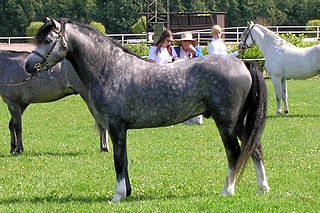
The Welsh Pony and Cob is a group of four closely-related horse breeds including both pony and cob types, which originated in Wales. The four sections within the breed society for the Welsh breeds are primarily distinguished by height, and also by variations in type: the smallest Welsh Mountain Pony ; the slightly taller but refined Welsh Pony of riding type popular as a children's show mount; the small but stocky Welsh Pony of Cob Type, popular for riding and competitive driving; and the tallest, the Welsh Cob, which can be ridden by adults. Welsh ponies and cobs in all sections are known for their good temperament, hardiness, and free-moving gaits.
The Central Wales Football League(formerly the Mid Wales Football League) is a football league in Wales at tier four of the Welsh Football pyramid, run by the Central Wales Football Association. The league consists of two regionally based divisions - a Northern Division and a Southern Division. The league offers a promotion route to the Football Association of Wales administered tier three Ardal Leagues. Relegation is possible to the relevant tier five level leagues in Aberystwyth, Ceredigion and Montgomeryshire.

The Royal Cornwall Agricultural Show, usually called the Royal Cornwall Show, is an agricultural show organised by the Royal Cornwall Agricultural Association, which takes place at the beginning of June each year, at Wadebridge in north Cornwall, England, United Kingdom. The showground is on the south side of the A39 main road and between the hamlets of St Breock and Whitecross. Members of the Royal family often attend at the Show, including Prince Charles who is a supporter of the farming community. Princess Alexandra attended the 2009 show. The show lasts for three days and attracts approximately 120,000 visitors annually.
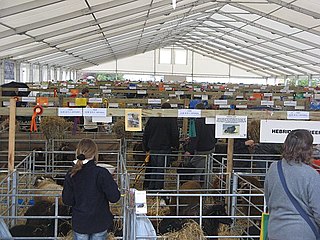
The Royal Highland Show is Scotland's biggest annual Agricultural show. The show is organised by the Royal Highland and Agricultural Society of Scotland.

Brynle Williams was a Welsh Conservative politician who was the Shadow Minister for Rural Affairs from 2007 to 2011, and a Member of the Welsh Assembly (AM) for the North Wales Region from 2007 to his death in 2011. Williams, who was a farmer from North Wales, was a colourful political figure who was respected for his straight talking and campaigning on rural issues; although privately he admitted he never saw himself as a politician.

A cob is traditionally a draft type pony. Typically of a stout build, with strong bones, large joints, and steady disposition, it is a body type of horse rather than a specific breed. Historically, in the United Kingdom and, to a lesser extent, the eastern United States, a 'cob' may be a common horse used for everyday riding but in the past was used for driving carts.
Countryside Live is the sister event of the annual farming and rural showcase, the Great Yorkshire Show. It is held during October, at the Great Yorkshire Showground in the town of Harrogate, England. The public two-day event is designed to act as a shop window for the farming industry. The show has been organised by the Yorkshire Agricultural Society every year since it was first held in 2001.

Mountain and moorland ponies form a group of several breeds of ponies and small horses native to the British Isles. Many of these breeds are derived from semi-feral ponies kept on moorland or heathland, and some of them still live in this way, as well as being kept as fully domesticated horses for riding, driving, and other draught work, or for horse showing.
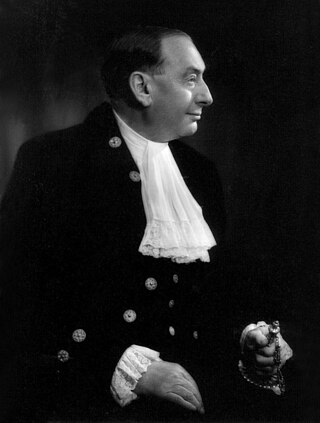
Robert William Griffiths was a British farmer and businessman whose principal interests lay in dairy farm production in Wales. The Griffiths philosophy was to explore all markets, pinpoint the best and gear production to exploit it. He was appointed High Sheriff of Montgomeryshire in 1953.

Mynydd Epynt is a former community and upland area in Powys, Wales.

The Norman Cob or Cob Normand is a breed of light draught horse that originated in the region of Normandy in northern France. It is of medium size, with a range of heights and weights, due to selective breeding for a wide range of uses. Its conformation is similar to a robust Thoroughbred, and it more closely resembles a Thoroughbred cross than other French draught breeds. The breed is known for its lively, long-striding trot. Common colours include chestnut, bay and seal brown. There are three general subsets within the breed: horses used under saddle, those used in harness, and those destined for meat production. It is popular for recreational and competitive driving, representing France internationally in the latter, and is also used for several riding disciplines.

The woollen industry in Wales was at times the country's most important industry, though it often struggled to compete with the better-funded woollen mills in the north of England, and almost disappeared during the 20th century. There is continued demand for quality Welsh woollen products.

Agriculture in Wales has in the past been a major part of the economy of Wales, a largely rural country which is part of the United Kingdom. Wales is mountainous and has a mild, wet climate. This results in only a small proportion of the land area being suitable for arable cropping, but grass for the grazing of livestock is present in abundance. As a proportion of the national economy, agriculture is now much less important; a high proportion of the population now live in the towns and cities in the south of the country and tourism has become an important form of income in the countryside and on the coast. Arable cropping is limited to the flatter parts and elsewhere dairying and livestock farming predominate.
